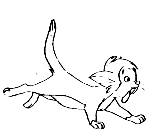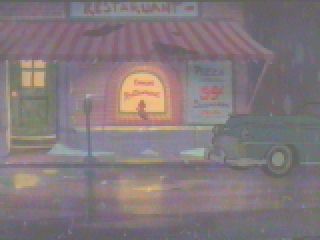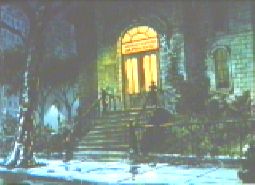
As AV turns 15, let's take a look back at the site we descended from. Below you can explore the database Olivier compiled at Animated Movies during its existence, as it last appeared online in October 2003.
 | Animated Movies was launched by Olivier Mouroux in 1999. In addition to a daily news report, he also created a database of information about past, current, and upcoming films. In 2003, he took a job in the industry and had to give up his work on the site. Several fans of Animated Movies decided to take on the task of keeping the news portion of his site going, and founded what is now Animated Views. As AV turns 15, let's take a look back at the site we descended from. Below you can explore the database Olivier compiled at Animated Movies during its existence, as it last appeared online in October 2003. |

 Directed
by: Don Bluth
Directed
by: Don Bluth
Written by:
Music by: Robert F. Brunner
Production Started on: March 1975
Released on: 1979 in the U.S., 1984 in
Finland (TV) and 1999 in Italy (video)
Running Time: 27 minutes
Budget: $13,000 (for composer, musicians
and studio time)
Box-Office: $ in the U.S., $ million worldwide
 Crazy
Legs... Scatman Crothers
Crazy
Legs... Scatman Crothers
Zazu... Beah Richards
 |
 |
 |
 |
![]() Banjo the Woodpile
Cat, a short film based on a kitten who lived under a woodpile on Don's
farm when he was young, was the fist feature produced by Don Bluth, Gary
Goldman and John Pomeroy. The film was intended more as a learning
exercise for the group of artists who contributed work to the feature than
as a feature in its own right. Work, beginning with gathering production
equipment began in 1972, John Pomeroy joined Don and Gary in 1973 and production
commenced on Banjo from 1975.
Banjo the Woodpile
Cat, a short film based on a kitten who lived under a woodpile on Don's
farm when he was young, was the fist feature produced by Don Bluth, Gary
Goldman and John Pomeroy. The film was intended more as a learning
exercise for the group of artists who contributed work to the feature than
as a feature in its own right. Work, beginning with gathering production
equipment began in 1972, John Pomeroy joined Don and Gary in 1973 and production
commenced on Banjo from 1975.
![]() From conceptual
story sketches to finished animated painted cels, Banjo took 4 years, 9
months to complete. Approximately 90,000 man-hours went into the production
of this short subject. The artists were rediscovering techniques and incorporating
production values they felt had slipped away from the animation industry
for 2 decades.
From conceptual
story sketches to finished animated painted cels, Banjo took 4 years, 9
months to complete. Approximately 90,000 man-hours went into the production
of this short subject. The artists were rediscovering techniques and incorporating
production values they felt had slipped away from the animation industry
for 2 decades.
![]() The entire picture
was storyboarded with more than 1100 story sketches. Including both character
and special effects animation, there were approximately 60,000 cels xeroxed
and hand painted.
The entire picture
was storyboarded with more than 1100 story sketches. Including both character
and special effects animation, there were approximately 60,000 cels xeroxed
and hand painted.
![]() The project was
produced in Don Bluth's garage, where the artists reported on weekends
for new assignments. Much of the drawing and painting was done in the privacy
of their own homes. During the last 13 weeks of production in 1979, 26
artists were employed full time to complete the picture for a Christmas
showing in 2 Los Angeles theatres.
The project was
produced in Don Bluth's garage, where the artists reported on weekends
for new assignments. Much of the drawing and painting was done in the privacy
of their own homes. During the last 13 weeks of production in 1979, 26
artists were employed full time to complete the picture for a Christmas
showing in 2 Los Angeles theatres.
![]() A full 32-piece
orchestra scores the picture in a 1940's style. Director Don Bluth wrote
all the songs in Banjo the Woodpile Cat, melody and lyrics. He has
not written any music for the feature films that he has done independently
since then.
A full 32-piece
orchestra scores the picture in a 1940's style. Director Don Bluth wrote
all the songs in Banjo the Woodpile Cat, melody and lyrics. He has
not written any music for the feature films that he has done independently
since then.

![]() On its completion the film was offered to television. It was thought
by ABC that the film would make a good Christmas feature and so aspects
of Christmas were added: snow in the city, and the Santa Claus suit Crazy
wears during the "Old Man Trouble" song ("Stick with me"). Adding
Christmas and other story revisions supposedly caused continuity problems.
On its completion the film was offered to television. It was thought
by ABC that the film would make a good Christmas feature and so aspects
of Christmas were added: snow in the city, and the Santa Claus suit Crazy
wears during the "Old Man Trouble" song ("Stick with me"). Adding
Christmas and other story revisions supposedly caused continuity problems.
![]() There seems to
be similarity in style in places between Banjo and Disney's
The
Rescuers, which isn't really surprising given that Don Bluth was
Directing Animator on The Rescuers
at about the same time he was making Banjo!
There seems to
be similarity in style in places between Banjo and Disney's
The
Rescuers, which isn't really surprising given that Don Bluth was
Directing Animator on The Rescuers
at about the same time he was making Banjo!
 |
 |
 |
![]() Scatman Crothers (1910-1986) was also the voice of Scat Cat in Disney's
The
Aristocats.
Scatman Crothers (1910-1986) was also the voice of Scat Cat in Disney's
The
Aristocats.
Don Bluth and Gary Goldman answered fans
questions on their official
Website on January 22, 2002.
How many cleanup artist cleaned up the Banjo animation and
who were they?
Don Bluth: Wow! That was a long time ago. We worked on that
film in Don's garage from the Spring of 1975 to Dec.1979. Mostly nights
and weekends while working days at Disney. Most all of us worked on cleanup.
John Pomeroy keyed most of the extremes for the cleanup crew. I'd say maybe
12 or so. John P., Vera Lanpher (Law), Dave Spafford, Skip Jones, Sally
Voorheis, Sue Evans (Kroyer), Gary, Don, Cathy Dreifus, Dave Molina, Heidi
Guedel, Linda Miller, Emily Jiuliano and Lorna Pomeroy. There are credits
at the end of the video. However, They are fairly general and if an artist
worked as an animator that is the credit that was given. Some of the above
people performed several different functions on Banjo. There were only
26 people, total, on the project.
What percentage of rough animation did each of the three principals,
Don, John and Gary animate ?
Don Bluth: The three, Don, Gary and John did most of the animation.
Lorna, Heidi, Linda and Emily did about 4 minutes of the show. Don gave
everyone a couple of key poses to start their scenes. Remember, Don, Gary
and John started the project and worked steadily from March of 1975. The
others joined in but were not necessarily there every weekend. However,
when we left Disney in September of 1979, everyone worked their butts off
thru the first week of December.
Who photographed the story reels, pencil tests and finished cels
against backgrounds on the animation stand?
Don Bluth: Everyone was involved with this process. Don and
Carmen Oliver mixed paints and all the animators, cleanup artists and fx
artists jumped on the cell painting process. Gary and Don shot most of
the story boards and pencil tests. Don Story boarded the entire 27 minute
show. He provided one or two poses for every scene. Don mixed paint and
painted cells, cleaned up drawings and directed the voice recordings. He
animated some of the more difficult scenes in the dogs chase, the singing
cats sequence and Banjo running to find refuge in the electrical storm.
He also did all of the layouts. Gary animated, cut dialogue and built the
story reels, acted as editor, scene planner and camera man until the project
got some outside funds (4 years into the production), then we brought in
the people, who left Disney with us, to work full time from Sept. 13th
thru Dec. 10th. Joe Jiulianno (Emily's husband) came aboard and took over
the rostrum camera with Chuck Warren. Chuck's wife became our receptionist.
John Pomeroy would color Don's story sketches with pastels and magic markers,
animate and key for cleanup. He also helped paint cels in the last days.
Joe and Chuck worked 12 hours shifts to get the color scenes shot. We had
an assembly line method of shooting the cels. Everyone, at one time or
another, cleaned cels. Someone would unpackage the scene and double check
the order and check to be sure the cels had been cleaned of dust and other
minutia. Someone would put the cel on the camera pegs and smooth it out.
Joe or Chuck would double check all the camera coordinates with another
person calling out instructions from the X-sheet. They would clamp down
the glass platen and then shoot a frame (or two, which ever the x-sheet
called for). Some one else would remove the cel and stack them for repackaging.
It was a real family affair. It seemed like we were awake 24 hours a day,
seven days a week for the last few weeks.
How did Jim Coleman single handedly paint all of the backgrounds
in Banjo? Were they done over a period of years?
Don Bluth: Jim Coleman did all the Backgrounds for Banjo. There
were about 350 BGs. He worked freelance on the project for a couple of
years , all the while working at Disney during the days. He was very fast
and his work was great. We tried to get him to come out with us but Disney
raised his salary to a point that we could not compete for him. Luckily
we found Don Moore, Ron Diaz and Dave Goetz when recruiting artists for
NIMH
in early 1980.
... and Gary Goldman added this recap on February 22, 2003.
"The short film was produced in Don Bluth's garage (and house) between
March of 1975 and December 1979. Don Bluth, Gary Goldman and John Pomeroy
were employed at Walt Disney Productions during the day and worked on the
project nights and weekends for four and a half years. It was a project
that we started to learn more about all of the functions of making an animated
movie. We were employed as animators at Disney and the studio had told
us that we would be taking over the duties of the leaders of the department
in a few years. This thought of becoming leaders and not knowing all the
job functions of production scared us into making a short film on our own.
We had been concentrating on animation only. Banjo forced us to write the
script, storyboard, do the layouts, paint backgrounds, edit pictue and
sound, direct and record the voices, animate the characters, animate special
effects, create and cut sound effects, write songs (Don wrote all the songs
in Banjo), spot the film for scoring with composer Robert Brunner
(a Disney composer at the time), choose colors for the characters and special
effects, xerox the images onto the cels and paint the cels, shoot camera,
cut negative, time the picture at Technicolor labs, supervise a final mix
of the sound and deliver a release print to the theaters. It was a great
learning experience. We did a little of everything and organized everything.
There were about 26 artists involved over the whole production period.
The story is about a little boy (a cat) who runs away from home because
he is adventurous and keeps getting in trouble and disciplined. He's "not
having a good time". However, running away from home doesn't solve his
problem. He finds that it's scary and lonely when he gets away from his
family (running from the country to the big city). What he discovers is
that the good times, the very best times, are at home with his family.
The music was recorded with 32 musicians in LA. Don put a second mortgage
on his house to cover the $13,000 price tag for the composer, musicians
and studio time (1979)."